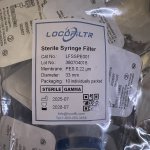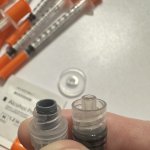50ShadesGreyMarket
GLP-1 Enthusiast
Inspired by a back-and-forth with @Nathanologist and his request to “explain it like I’m 5” I figured it wouldn’t be a bad idea to make a post regarding my personal process for filtering (will make another post regarding how I do endotoxin testing when I have time). All specs are based on my personal set-up. If you have different methods or suggestions feel free to add a comment.
Filtering:
First know the difference between hydrophobic and hydrophilic filters - you should use hydrophilic to filter liquids and hydrophobic to filter air. Obviously use the hydrophobic to equalize pressure in the vial, especially when air chasing the last few units from a vacuum sealed 10 mL vial - it’s annoying as all hell trying to pull the plunger with your pinky while holding the whole thing upside down, trying not to bend your needle or pull it through the stopper as it dulls the tip the more times you poke through the rubber. This gets easier with practice.
Filters don’t remove endotoxins but I always filter before testing just so there’s less of whatever isn’t peptides in the test. I use Gamma sterilized 33mm PES .22 µm - I’ll attach a pic.
(note: in case you run out of hydrophobic, a hydrophilic .22 µm filter will pass air when it’s dry)
For a 31g (needle gauge), the inner diameter is extremely small, around 0.1–0.12mm (100–120 µm). That means you need to match your syringe filter outlet (luer-lock) with this fine bore so the fluid can actually pass without clogging or backing up. I personally use 25g for filtering (draw up) and 31g for administering to my researchers. 😉
note: I regularly see people on here claim BAC “sterilizes” the solution and that is not wholly accurate. Alcohol will sanitize but it won’t sterilize, you need radiation or an autoclave and sealed glass knock box to ensure no viruses or spores contaminate your samples. Alcohol will leach into whatever you’re filtering unless properly flushed and that’s a whole extra step. Just use
pre-sterilized 0.22 µm syringe filter, low protein-binding membrane. PES or PVDF; cellulose acetate is also low-binding; avoid nylon for sensitive peptides due to higher binding, they’re inexpensive.
Simple steps:
-Attach 21–25g sterile needle to the sterile 10 mL luer-lock syringe
-Pierce the reconstituted peptide vial (stopper still dry), invert the vial, and withdraw the full volume slowly to minimize foaming
-Remove any obvious bubbles by tapping; do not push fluid back and forth through the needle (reduces shear/adsorption risk)
-Detach the needle from the syringe and attach the sterile 0.22 µm filter to the syringe (female luer on filter to syringe tip)
-Attach a fresh sterile 21–25g needle to the outlet of the filter (the filter’s male luer)
-Prime by gently pushing ~0.3–0.5 mL of the peptide solution through the filter to wet the membrane, discarding these first drops into waste
High IQ: use sterile ethanol to wet the filter thus saving the peptide that would otherwise go to waste
-Insert a sterile vent needle with 0.22 µm air filter into the empty sterile vial to let displaced air escape through a sterile barrier
-Scrub the receiving vial’s stopper again (quick pass, let dry ~10 s)
-Insert the outlet needle (on the filter) into the receiving vial. Keep the vial upright and the needle tip well inside the vial headspace/liquid
-Plunge slowly and steadily. A 13mm filter is sized for ≤10 mL; expect gentle resistance. If resistance spikes, pause for 10–15 s and resume
-Recover hold-up volume, when nearly done, keep the needle tip inside the vial and very gently push a small air bubble (≤0.3 mL) through to “chase” liquid out of the filter. Don’t blast air; slow and controlled avoids foaming/aerosol
-Withdraw the needle and remove the vent. You can vacuum seal it with a filter and about 10 mL air draw if you want but it’s fine due to the vent having a filter
Reminder: use PES/ PVDF/ CA for hydrophilic filters as nylon can bind to some peptides
Happy researching!
Filtering:
First know the difference between hydrophobic and hydrophilic filters - you should use hydrophilic to filter liquids and hydrophobic to filter air. Obviously use the hydrophobic to equalize pressure in the vial, especially when air chasing the last few units from a vacuum sealed 10 mL vial - it’s annoying as all hell trying to pull the plunger with your pinky while holding the whole thing upside down, trying not to bend your needle or pull it through the stopper as it dulls the tip the more times you poke through the rubber. This gets easier with practice.
Filters don’t remove endotoxins but I always filter before testing just so there’s less of whatever isn’t peptides in the test. I use Gamma sterilized 33mm PES .22 µm - I’ll attach a pic.
(note: in case you run out of hydrophobic, a hydrophilic .22 µm filter will pass air when it’s dry)
For a 31g (needle gauge), the inner diameter is extremely small, around 0.1–0.12mm (100–120 µm). That means you need to match your syringe filter outlet (luer-lock) with this fine bore so the fluid can actually pass without clogging or backing up. I personally use 25g for filtering (draw up) and 31g for administering to my researchers. 😉
note: I regularly see people on here claim BAC “sterilizes” the solution and that is not wholly accurate. Alcohol will sanitize but it won’t sterilize, you need radiation or an autoclave and sealed glass knock box to ensure no viruses or spores contaminate your samples. Alcohol will leach into whatever you’re filtering unless properly flushed and that’s a whole extra step. Just use
pre-sterilized 0.22 µm syringe filter, low protein-binding membrane. PES or PVDF; cellulose acetate is also low-binding; avoid nylon for sensitive peptides due to higher binding, they’re inexpensive.
Simple steps:
-Attach 21–25g sterile needle to the sterile 10 mL luer-lock syringe
-Pierce the reconstituted peptide vial (stopper still dry), invert the vial, and withdraw the full volume slowly to minimize foaming
-Remove any obvious bubbles by tapping; do not push fluid back and forth through the needle (reduces shear/adsorption risk)
-Detach the needle from the syringe and attach the sterile 0.22 µm filter to the syringe (female luer on filter to syringe tip)
-Attach a fresh sterile 21–25g needle to the outlet of the filter (the filter’s male luer)
-Prime by gently pushing ~0.3–0.5 mL of the peptide solution through the filter to wet the membrane, discarding these first drops into waste
High IQ: use sterile ethanol to wet the filter thus saving the peptide that would otherwise go to waste
-Insert a sterile vent needle with 0.22 µm air filter into the empty sterile vial to let displaced air escape through a sterile barrier
-Scrub the receiving vial’s stopper again (quick pass, let dry ~10 s)
-Insert the outlet needle (on the filter) into the receiving vial. Keep the vial upright and the needle tip well inside the vial headspace/liquid
-Plunge slowly and steadily. A 13mm filter is sized for ≤10 mL; expect gentle resistance. If resistance spikes, pause for 10–15 s and resume
-Recover hold-up volume, when nearly done, keep the needle tip inside the vial and very gently push a small air bubble (≤0.3 mL) through to “chase” liquid out of the filter. Don’t blast air; slow and controlled avoids foaming/aerosol
-Withdraw the needle and remove the vent. You can vacuum seal it with a filter and about 10 mL air draw if you want but it’s fine due to the vent having a filter
Reminder: use PES/ PVDF/ CA for hydrophilic filters as nylon can bind to some peptides
Happy researching!
Attachments
Last edited:


